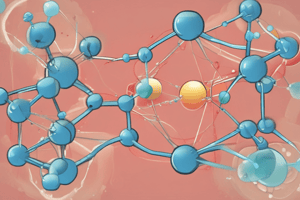Podcast
Questions and Answers
Explain why sodium (Na) readily forms a $1^+$ cation, while chlorine (Cl) readily forms a $1^-$ anion. Relate your answer to the octet rule.
Explain why sodium (Na) readily forms a $1^+$ cation, while chlorine (Cl) readily forms a $1^-$ anion. Relate your answer to the octet rule.
Sodium needs to lose one electron to achieve a full octet whereas chlorine needs to gain one electron to achieve a full octet.
How does the concept of electronegativity relate to the formation of ionic bonds?
How does the concept of electronegativity relate to the formation of ionic bonds?
A large difference in electronegativity between two atoms leads to an ionic bond as one atom strongly attracts electrons from the other.
Predict the chemical formula of the ionic compound formed between aluminum ($Al$) and oxygen ($O$). Explain the reasoning behind your prediction.
Predict the chemical formula of the ionic compound formed between aluminum ($Al$) and oxygen ($O$). Explain the reasoning behind your prediction.
The chemical formula would be $Al_2O_3$ because Aluminum forms a $3^+$ cation and Oxygen forms a $2^-$ anion. To balance the charges we need two aluminum ions for every three oxide ions.
Consider a hypothetical ionic compound, $AB_2$, where A is a metal and B is a non-metal. If element A typically forms a $2^+$ cation, what charge would you expect element B to have as an anion?
Consider a hypothetical ionic compound, $AB_2$, where A is a metal and B is a non-metal. If element A typically forms a $2^+$ cation, what charge would you expect element B to have as an anion?
Explain why ionic compounds generally have higher melting and boiling points compared to molecular compounds.
Explain why ionic compounds generally have higher melting and boiling points compared to molecular compounds.
Ammonium phosphate, $(NH_4)_3PO_4$, is an ionic compound containing two polyatomic ions. Identify the polyatomic ions present and describe the role they play in forming the compound.
Ammonium phosphate, $(NH_4)_3PO_4$, is an ionic compound containing two polyatomic ions. Identify the polyatomic ions present and describe the role they play in forming the compound.
Describe what happens to the electrical conductivity of solid, crystalline NaCl when it is dissolved in water? Explain why this change occurs.
Describe what happens to the electrical conductivity of solid, crystalline NaCl when it is dissolved in water? Explain why this change occurs.
If a solid sample of an unknown compound is found to conduct electricity and has a high melting point, would you predict it is likely an ionic compound or a molecular compound? Explain.
If a solid sample of an unknown compound is found to conduct electricity and has a high melting point, would you predict it is likely an ionic compound or a molecular compound? Explain.
Flashcards
Cation
Cation
A positively charged ion formed when an atom loses electrons.
Anion
Anion
A negatively charged ion formed when an atom gains electrons.
Valence Electrons
Valence Electrons
Electrons in the outermost energy level of an atom.
Octet Rule
Octet Rule
Signup and view all the flashcards
Ionic Bond
Ionic Bond
Signup and view all the flashcards
Ionic Compound Formula
Ionic Compound Formula
Signup and view all the flashcards
Polyatomic Ion
Polyatomic Ion
Signup and view all the flashcards
Ionic Compound Formula Meaning
Ionic Compound Formula Meaning
Signup and view all the flashcards
Study Notes
- A neutral atom loses one or more electrons to form a cation.
- Calcium (Ca) becomes a calcium cation ($Ca^{2+}$) by losing two electrons.
- A neutral atom gains one or more electrons to form an anion.
- Oxygen (O) becomes an oxide anion ($O^{2-}$) by gaining two electrons.
- Valence electrons are at the outermost occupied energy level, higher in energy, and have the same charge and mass as any other electron.
- Neutral atoms have the following number of valence electrons:
- Sodium (Na): 1
- Nitrogen (N): 5
- Argon (Ar): 8
- Magnesium (Mg): 2
- Sulfur (S): 6
- Chlorine (Cl): 7
- Using the octet rule, the charge of the following atoms when they become ions:
- Sodium (Na): 1+
- Nitrogen (N): 3-
- Argon (Ar): 0
- Magnesium (Mg): 2+
- Sulfur (S): 2-
- Chlorine (Cl): 1-
- Oppositely charged cations and anions attract one another, holding ionic bonds together.
- Ionic compounds show a metal (or $NH_4^+$) ion at the beginning, while molecular compounds show only two nonmetals.
- A polyatomic ion is multiple atoms bonded together that function as an individual ion.
- The chemical formula for an ionic compound, such as $Fe_2O_3$, tells the ratio of cations to anions in the larger crystal lattice structure, describing the composition of the substance in detail.
- Ionic compounds are electrically neutral because the ratio of cations to anions will always be such that the positive charges exactly cancel the negative charges.
- A compound that is a liquid at room temperature, has a melting point of -25°C, and does not conduct electricity is most likely made of molecules because its low melting point suggests that it is not a solid at room temperature.
Studying That Suits You
Use AI to generate personalized quizzes and flashcards to suit your learning preferences.




